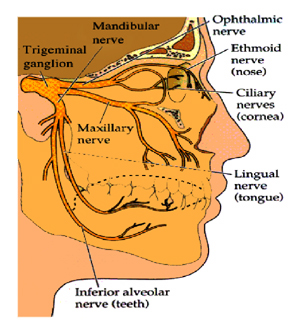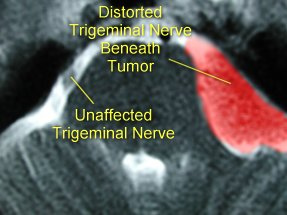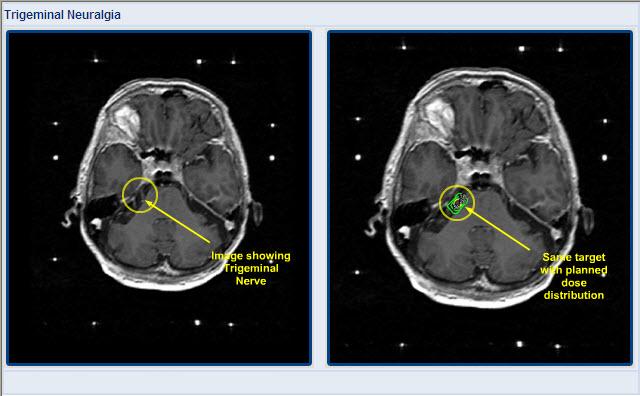Gamma Knife Surgery
Non Invasive Brain Surgery
Gamma Knife Clinic
Mumbai , India
ph: +919821313033
gamma
- Gamma Knife - Home
- Gamma Knife Surgery
- What can be treated
- GK Treatment Process
- GK for Trigeminal Neuralgia
- Gamma Knife for Gliomas
- GK for Glioblastoma Multiforme (GBM)
- GK for Pituitary Adenoma
- Gamma Knife for Chordoma
- Gamma Knife for Acoustic Neuroma
- GK for Brain Metastases
- Gamma Knife for Meningioma
- Craniopharyngioma
- Gamma Knife for AVM
- Gamma Knife for Parkinson's Disease
- Gamma Knife for Essential Tremors
- Gamma Knife for Obsessive Compulsive disorder ( OCD )
- Gamma Knife News
- CyberKnife Radiosurgery
- Links
- Media
- Video Gallery
- Gamma Knife Research
- Contact us
Gamma Knife Treatment for Trigeminal Neuralgia
Trigeminal neuralgia is characterized by sudden bursts (paroxysms) of face pain. These bursts are often triggered by a light touch around the mouth or face or by talking, eating, or brushing one's teeth. The pain sometimes gets worse or better for periods of weeks or months. The pain is in the areas supplied by the trigeminal nerve: the cheeks, jaw, teeth, gums, lips and less often around the eye or forehead. Usually pain occurs on just one side of the face, but in five to 10 percent of patients, pain occurs on both sides of the face, although not at the same time. The pain responds to Tegretol (Carbamazepine is the generic name), but sometimes the dose has to be increased and unpleasant side effects can occur.
http://www.trigeminalneuralgia.in
The cause of trigeminal neuralgia is not always certain. Approximately five percent of patients have a tumor pressing on the trigeminal nerve where it leaves the brain, while other patients have a blood vessel that presses on the trigeminal nerve, close to the brain. In some patients the cause cannot be determined. Approximately five percent of patients with trigeminal neuralgia have multiple sclerosis. Patients with TN and multiple sclerosis are generally younger, and tend to first experience TN symptoms while in their mid 40s. These patients are more likely to have pain on both sides of the face (bilateral trigeminal neuralgia) and often have other neurological abnormalities
http://www.gammaknife.in/treatmentprocess.html
Gamma Knife radiosurgery is a major advance in the treatment of trigeminal neuralgia, an otherwise agonizing condition characterized by paroxysmal triggered face pain. Gamma Knife radiosurgery not only relieves the pain as well as the other neurosurgical forms of treatment, but it does so with fewer complications.
Any patient with trigeminal neuralgia who has pain or has difficulty with the medicines used to relieve the pain is an excellent candidate for GKRS. The patient's age or medical condition does not affect the decision to have GKRS. Even the elderly or medically infirm can undergo this treatment. Patients who are receiving anticoagulants for other medical conditions do not have to stop or reverse the anticoagulation therapy prior to GKRS. Those who have had previous procedures for TN may also undergo GKRS. Patients who are concerned about the possibility of numbness are particularly good candidates for GKRS, because the chance of postoperative numbness occurring is very small. Patients who poorly tolerate medicines given for sedation and relief of pain during a procedure are also very suitable for GKRS because these medications are not necessary.
http://www.trigeminalneuralgia.in/
Excellent or good pain relief occurs in approximately 90 to 95 percent of patients. Onset of pain relief may occur one day to three months after the procedure. More than half of patients will experience pain relief within four weeks. Recurrent pain occurs within three years in 5 percent of patients. Patients with TN and multiple sclerosis also may be helped by the procedure.
Major complications have not been reported. Additional numbness in the face or new facial sensations occur in less than 5 percent of patients.


http://www.trigeminalneuralgia.in/
Dr.Sanjay Mongia , Gamma Knife Clinic . EMAIL : gamma@gammaknifeonline.in Ph: 9821313033 . All rights reserved.
BLOG : http://gammaknifeasia.blogspot.com/
Gamma Knife Clinic
Mumbai , India
ph: +919821313033
gamma
